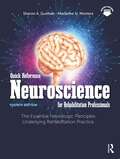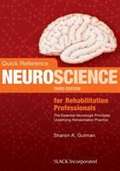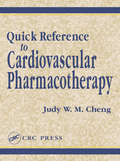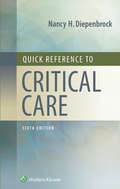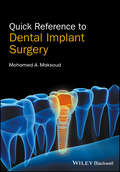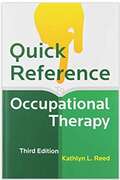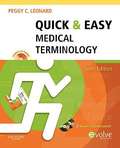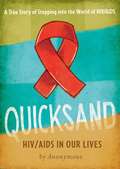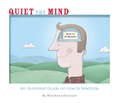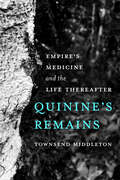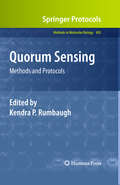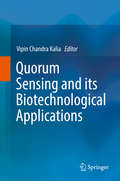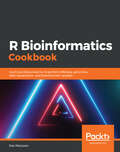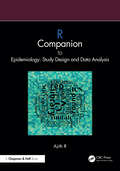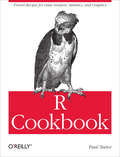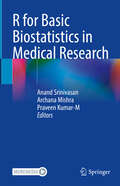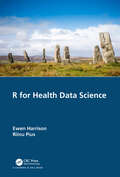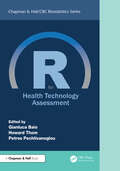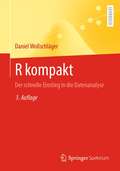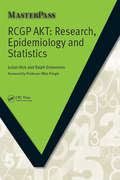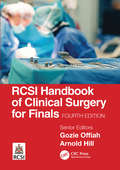- Table View
- List View
Quick Reference Neuroscience for Rehabilitation Professionals: The Essential Neurologic Principles Underlying Rehabilitation Practice
by Sharon A. Gutman Marianne H. MorteraThe fourth edition of this concise and accessible book continues to provide readers with the fundamentals of clinical neuroscience, the essentials of neurological functioning, and the neurological basis for a range of rehabilitation practices.The book starts by illustrating the basics of neuroanatomy, before addressing the function of neurological systems underlying motor, sensory, visual, perceptual, cognitive, emotional, and memory disorders. Along with new full color illustrations and photographs, the book has been updated to include the following additional material: Full screening procedures have been added to the cranial nerve section. Full color illustrations have been added to the special sense receptor section to illustrate the clinical pathology underlying visual field impairments. New sections have been added addressing attention and cognition. A subsection, "Occupational Performance Implications," was added to all sections to help readers understand how function/dysfunction of neuroanatomical systems impact performance in daily life activities. This updated fourth edition continues to be essential reading for any healthcare professional working in rehabilitation, or students on the journey to become rehabilitation professionals.
Quick Reference Neuroscience for Rehabilitation Professionals: The Essential Neurologic Principles Underlying Rehabilitation Practice
by Sharon A. GutmanA concise and quick reference for the practitioner and student who are learning or reviewing the most relevant neuroscience principles supporting rehabilitation therapy. The updated third edition continues to meet a need in the rehabilitation profession that has gone unfilled - the ability to break down neuroscience information into the essential principles that can be used to understand neurological conditions and the principles underlying rehabilitation evaluation and practice. This fully-updated third edition provides a quick review of specific neuroscience concepts and principles that support rehabilitation interventions. In this era of information overload, this text rapidly and thoroughly provides condensed information in a user-friendly, easy-to-use format for readers to review and convey relevant information to patients. Sharon Gutman has organised the text into three parts: the first addresses neuroanatomy; the second addresses the function of neurological systems underlying physical, psychiatric, cognitive, and visual perceptual disorders; and the final section addresses clinical neuropathology related to ageing, addiction, memory, and the neurological substrates of sex and gender. A specific section describes the common neurodiagnostic tests that therapists do not administer but must have knowledge of when results are discussed at treatment team meetings. Features of the third edition: Presented in a simple and organised bulleted format. Large-scale colour illustrations to easily visualise neuroanatomical structures and systems. Text boxes to apply key neuroscience concepts to the understanding of common neurological disorders and treatment. Updated clinical test questions and glossary. The third edition bridges a gap by quickly providing the rehabilitation professional with the most salient information needed to understand neurologic principles underlying rehabilitation practice.
Quick Reference to Cardiovascular Pharmacotherapy (Pharmacy Education Series)
by Judy W. M. ChengCardiovascular disease is the leading cause of death in the United States and is the focus of ongoing research. Consequently, treatment of cardiovascular disorders is among the most highly evidence-based area of medicine and pharmacy practice.Quick Reference to Cardiovascular Pharmacotherapy provides important guidelines and standards of ca
Quick Reference to Critical Care
by Nancy H. DiepenbrockThis indispensable pocket guide addresses a broad range of critical care patient topics, divided by body system and organized alphabetically within each chapter for quick access. Disease processes, disorders, medications, and titration, tests, lab results, formulas, ICU equipment and treatment strategies and goals are discussed. Each well-illustrated entry explains the latest evidence-based procedures and stabilization practices in a convenient, quick-read outline, making it the ideal quick reference for following proven protocols.
Quick Reference to Dental Implant Surgery
by Mohamed A. MaksoudQuick Reference to Dental Implant Surgery offers busy practitioners quick access to all the essential information needed for successful dental implant surgery—from case selection to radiographic examination, scrub-in to post-operative care. How-to information in a concise, spiral-bound, quick-access format Concrete guidelines for common scenarios before, during, and after surgery Numerous charts, tables, checklists, and callouts An abundance of stunning, full-color photographs illustrating key points covered Text boxes containing clinical recommendations to help facilitate quick navigation
Quick Reference to Occupational Therapy
by Kathlyn L. ReedThis greatly enhanced and expanded Third Edition of Quick Reference to Occupational Therapy adds sixty-five topics and disorders to the already extensive list. All information in the text is updated. New and veteran therapists will benefit from having the latest disorder-specific information at their fingertips as they assess and treat clients. An extensive References for Further Reading section includes a review of the levels of evidence for each journal article. <p><p>Contents include: Developmental Disorders Sensory Disorders, Nervous System Disorders, Cardiopulmonary Disorders, Hand and Wrist Conditions, Injuries, Musculoskeletal Disorders, Systemic Disorders, Immunologic and Infectious Diseases, Skin Disorders, Cognitive-Perceptual Disorders, and Mental Disorders Lifestyle Disorders,
Quick and Easy Medical Terminology (6th Edition)
by Peggy C. LeonardMake learning medical terminology faster and more fun with Quick & Easy Medical Terminology, 6th Edition! Featuring CDs with interactive games and audio pronunciations, this book helps you begin reading, writing, and speaking medical terms in the shortest time possible. Small chunks of information are always followed immediately by exercises, so students will be learning "every minute!" The many puzzles, activities, and games make it easier to understand and remember terminology. Written in a clear, conversational style by Peggy C. Leonard, MT, MEd, this book gives you the tools to communicate effectively in the health care environment. A companion CD reinforces learning with fun, interactive exercises, including medical reports and Hear It/Spell It exercises. Two audio CDs let you listen to correct pronunciations of medical terms and encourage you to pronounce each term aloud. A flexible, body systems organization lets you go through the material in any order after completing the orientation chapters, making it easy to coordinate your study with other courses such as anatomy and physiology. The programmed learning approach presents content in small blocks called 'frames' that allow you to learn the content and get immediate feedback on your progress before proceeding. Diverse learning styles are accommodated by a wide variety of exercises -- labeling diagrams, writing terms, choosing pronunciation accents, recognizing misspelled terms, matching word parts, interpreting terms within health reports, and categorizing terms. Unique! A conversational writing style makes the book more readable and enjoyable. Unique! Thorough explanations of terms help you understand and remember the material by presenting terminology in a medical context. A consistent format to body systems chapters uses categories to simplify the learning of terms, with each chapter including function; structure; diseases, disorders, and diagnostic terms; and surgical and therapeutic interventions. Healthcare reports and case studies allow you to apply your knowledge to real-life situations. A review of anatomy and physiology at the beginning of each body systems chapter provides a context for understanding the medical terminology. Drug information is integrated into the body systems chapters, with detailed information on specific drugs on CD. Caution boxes alert you to confusing terms. Spanish translations of key terms are listed in each chapter to help you communicate with Hispanic patients; glossaries are included in the appendix. Comprehensive end-of-chapter reviews correspond to the learning objectives at the beginning of the chapter. A bookmark includes a quick-reference guide to pronouncing terms plus a list of pronunciation symbols. A companion Evolve website includes study tips, electronic flashcards, Body Spectrum coloring pages, an English/Spanish glossary, learning activities that include Spanish term exercises, updates, and links to related sites. More short exercises include Find the Clue and Connections puzzles, letting you check your learning more often and stay on track. Procedures and terminology updates keep you current with new technologies and terms you'll encounter in the workplace. Quick Tips in the margins add essential information and interesting, fun facts. Games add fun and competition to exercises on the companion CD. More medical reports with exercises are included on the CD, allowing you to use terms in real-life situations.
Quicksand: HIV/AIDS in Our Lives
by Anonymous<P>What is it like to be affected by HIV/AIDS? <P>A moving first-person account offers insight- and basic facts. <P>One day I found out that someone I know- my brother-in-law, Jay- had HIV/AIDS. <P>At the moment I heard his diagnosis, I realized that I had stepped into the quicksand of a new and terrible world -- and I was sinking fast. <P>Weaving together her own story with straightforward questions and answers, the author explains the real ways that HIV/AIDS can be transmitted and explores the common experiences and emotions that might be encountered by friends and family members of someone who has the virus. <P>She also discusses why HIV/AIDS is often still kept a secret and the importance of treating this condition like any other. <P>With up-to-date medical information that has been thoroughly vetted by experts, this first-person narrative offers an invaluable look at what it is like to watch someone you know battle HIV/AIDS.
Quiet the Mind
by Matthew JohnstoneIn a world where finding even ten minutes to 'do nothing' can be difficult, the benefits of meditation can be profound. Meditation is simply a way of giving our brains a well-deserved break and can actually help our brains to function healthily and happily. This beautifully illustrated guide is an inspiring and practical book which shows you how to meditate without the need for uncomfortable lotus positions or prayer beads! With his typical gentle and insightful humour, Matthew's guide to meditation will enable to you to feel more present, more youthful, have more energy and greater concentration, improve your mood and sleep more soundly.
Quinine's Remains: Empire's Medicine and the Life Thereafter
by Townsend MiddletonA free ebook version of this title is available through Luminos, University of California Press's Open Access publishing program. Visit www.luminosoa.org to learn more. What happens after colonial industries have run their course—after the factory closes and the fields go fallow? Set in the cinchona plantations of India’s Darjeeling Hills, Quinine’s Remains chronicles the history and aftermaths of quinine. Harvested from cinchona bark, quinine was malaria’s only remedy until the twentieth-century advent of synthetic drugs, and it was vital to the British Empire. Today, the cinchona plantations—and the roughly fifty thousand people who call them home—remain. Their futures, however, are unclear. The Indian government has threatened to privatize or shut down this seemingly obsolete and crumbling industry, but the plantation community, led by strident trade unions, has successfully resisted. Overgrown cinchona fields and shuttered quinine factories may appear the stuff of postcolonial and postindustrial ruination, but quinine’s remains are not dead. Rather, they have become the site of urgent efforts to redefine land and life for the twenty-first century. Quinine's Remains offers a vivid historical and ethnographic portrait of what it means to forge life after empire.
Quintessential Occupational Therapy: A Guide to Areas of Practice
by Robin AkselrudOffering a glimpse into the daily schedule, caseload, and roles of clinicians in more than 15 areas of practice, Quintessential Occupational Therapy: A Guide to Areas of Practice is an essential resource for recent graduates and occupational therapists looking to enter a new area of practice.Each chapter focuses on a different area of practice—from outpatient rehabilitation to home care—and is authored by a team of seasoned clinicians who offer advice, work samples, and tips for those entering that area of practice. Quintessential Occupational Therapy also features experts across states and settings to provide the reader with a holistic view and understanding of the practice area they seek to enter.What’s included in Quintessential Occupational Therapy: Sample forms and documents used in a variety of practice settings Common treatment plans and information on clinical diagnoses in each area of practice Guides for testing and relevant clinical information for each setting Quintessential Occupational Therapy: A Guide to Areas of Practice will equip readers with the knowledge and understanding of a variety of practice settings in occupational therapy and is perfect for recent graduates and practicing clinicians alike.
Quirks of Human Anatomy: An Evo-devo Look at the Human Body
by Lewis I. Held Jr.With the emergence of the new field of evolutionary developmental biology we are witnessing a renaissance of Darwin's insights 150 years after his Origin of Species. Thus far, the exciting findings from "evo-devo" have only been trickling into college courses and into the domain of non-specialists. With its focus on the human organism, Quirks of Human Anatomy opens the floodgates by stating the arguments of evo-devo in plain English, and by offering a cornucopia of interesting case studies and examples. Its didactic value is enhanced by 24 schematic diagrams that integrate a host of disparate observations, by its Socratic question-and-answer format, and by its unprecedented compilation of the literature. By framing the "hows" of development in terms of the "whys" of evolution, it lets readers probe the deepest questions of biology. Readers will find the book not only educational but also enjoyable, as it revels in the fun of scientific exploration.
Quorum Sensing
by Kendra P. RumbaughSince its early days in the 1990s, the Quorum Sensing (QS) field has grown from a few dozen laboratories, investigating the pathways, proteins, and chemicals that facilitate signaling in bacteria, to hundreds of groups that have integrated evolutionary biology, computer science, mathematics, engineering, and metagenomics to create an ever-expanding and dynamic field. In Quorum Sensing: Methods and Protocols, expert researchers provide an in-depth set of diverse protocols that span this broad area of study. Broken into three detailed sections, the volume covers the detection, isolation, and characterization of the QS signals made by both Gram- and Gram+ bacteria, determination of the function of QS signals in vivo, and the development of QS disruption strategies. Written in the highly successful Methods in Molecular BiologyTM series format, chapters include brief introductions to their respective topics, lists of the necessary materials and reagents, step-by-step, readily reproducible laboratory protocols, and expert tips on troubleshooting and avoiding known experimental pitfalls. Comprehensive and cutting-edge, Quorum Sensing: Methods and Protocols serves as an invaluable collection of easily accessible techniques for scientists seeking to further our knowledge about bacterial communication and its relation to humanity.
Quorum Sensing and its Biotechnological Applications
by Vipin Chandra KaliaThis book delves into the biotechnological applications of Quorum sensing (QS)- a peculiar gene-regulatory process of some microorganisms. Quorum Sensing allows a large bacterial population to work together in a coordinated manner to carry out metabolic activities, which individual bacterium cannot. The different chapters describe how, associating bioremediation process with energy generation is an economical proposal, for reducing pollution and managing biowastes. The book discusses how QS can be exploited for biotechnological applications in generating bioproducts, bioenergy, bioremediation, biosensors, health and agricultural activities. It further highlights how QS is becoming an integral part of synthetic biology for genetic circuits for producing: (i) novel products, (ii) biosensors, (iii) bioactive molecules, etc. The book is divided into different sections for a clear understanding of the applicability of QS in, the Environment, Energy, Agriculture and Health sectors.
R Bioinformatics Cookbook: Use R and Bioconductor to perform RNAseq, genomics, data visualization, and bioinformatic analysis
by Dan MacLeanOver 60 recipes to model and handle real-life biological data using modern libraries from the R ecosystem Key Features Apply modern R packages to handle biological data using real-world examples Represent biological data with advanced visualizations suitable for research and publications Handle real-world problems in bioinformatics such as next-generation sequencing, metagenomics, and automating analyses Book Description Handling biological data effectively requires an in-depth knowledge of machine learning techniques and computational skills, along with an understanding of how to use tools such as edgeR and DESeq. With the R Bioinformatics Cookbook, you'll explore all this and more, tackling common and not-so-common challenges in the bioinformatics domain using real-world examples. This book will use a recipe-based approach to show you how to perform practical research and analysis in computational biology with R. You will learn how to effectively analyze your data with the latest tools in Bioconductor, ggplot, and tidyverse. The book will guide you through the essential tools in Bioconductor to help you understand and carry out protocols in RNAseq, phylogenetics, genomics, and sequence analysis. As you progress, you will get up to speed with how machine learning techniques can be used in the bioinformatics domain. You will gradually develop key computational skills such as creating reusable workflows in R Markdown and packages for code reuse. By the end of this book, you'll have gained a solid understanding of the most important and widely used techniques in bioinformatic analysis and the tools you need to work with real biological data. What you will learn Employ Bioconductor to determine differential expressions in RNAseq data Run SAMtools and develop pipelines to find single nucleotide polymorphisms (SNPs) and Indels Use ggplot to create and annotate a range of visualizations Query external databases with Ensembl to find functional genomics information Execute large-scale multiple sequence alignment with DECIPHER to perform comparative genomics Use d3.js and Plotly to create dynamic and interactive web graphics Use k-nearest neighbors, support vector machines and random forests to find groups and classify data Who this book is for This book is for bioinformaticians, data analysts, researchers, and R developers who want to address intermediate-to-advanced biological and bioinformatics problems by learning through a recipe-based approach. Working knowledge of R programming language and basic knowledge of bioinformatics are prerequisites.
R Companion to Epidemiology: Study Design and Data Analysis
by Ajith RR Companion to Epidemiology: Study Design and Data Analysis is a companion volume to the classic textbook by Mark Woodward, Epidemiology: Study Design and Data Analysis, Third Edition. It aims to equip the reader with sufficient knowledge to use R for practising epidemiology. Towards this aim, it reworks the examples in the textbook, presenting the code followed by an explanation and its result.Key Features: Almost all of the numerical examples in the textbook are reworked in R R code is introduced in small portions and explained thoroughly Complexity of introduced code is increased only gradually More than 300 commands spanning more than 40 libraries are introduced The book is intended primarily to be used as a supplement to the textbook by undergraduate and graduate students in the fields of epidemiology and statistics. It will also serve practitioners and researchers in epidemiology who want to learn R for use in their work.
R Cookbook: Proven Recipes for Data Analysis, Statistics, and Graphics (Cookbook Ser.)
by Paul TeetorWith more than 200 practical recipes, this book helps you perform data analysis with R quickly and efficiently. The R language provides everything you need to do statistical work, but its structure can be difficult to master. This collection of concise, task-oriented recipes makes you productive with R immediately, with solutions ranging from basic tasks to input and output, general statistics, graphics, and linear regression. Each recipe addresses a specific problem, with a discussion that explains the solution and offers insight into how it works. If you're a beginner, R Cookbook will help get you started. If you're an experienced data programmer, it will jog your memory and expand your horizons. You'll get the job done faster and learn more about R in the process. Create vectors, handle variables, and perform other basic functions Input and output data Tackle data structures such as matrices, lists, factors, and data frames Work with probability, probability distributions, and random variables Calculate statistics and confidence intervals, and perform statistical tests Create a variety of graphic displays Build statistical models with linear regressions and analysis of variance (ANOVA) Explore advanced statistical techniques, such as finding clusters in your data "Wonderfully readable, R Cookbook serves not only as a solutions manual of sorts, but as a truly enjoyable way to explore the R language--one practical example at a time." --Jeffrey Ryan, software consultant and R package author
R for Basic Biostatistics in Medical Research
by Anand Srinivasan Archana Mishra Praveen Kumar-MThe scientific community at the global level is fast becoming aware of the rising use of open-source tools such as R and Python for data analysis. Unfortunately, in spite of the awareness, the conversion of the intrigue to the practical knowledge in utilization of the open-source tools for routine day-to-day data analysis is seriously lacking both among physicians and medical scientists. This book enables physician-scientists to understand the complexity of explaining a programming/ data-analytic language to a healthcare professional and medical scientist. It simplifies and explains how R can be used in medical projects and routine office works. It also talks about the methodologies to convert the knowledge to practice. The book starts with the introduction to the structure of R programming language in the initial chapters, followed with explanations of utilizing R in the basics of data analysis like data importing and exporting, operations on a data frame, parametric and non-parametric tests, regression, sample size calculation, survival analysis, receiver operator characteristic analysis (ROC) and techniques of randomization. Each chapter provides a brief introduction to the involved statistics, for example, dataset, working codes, and a section explaining the codes. In addition to it, a chapter has been dedicated to describing the ways to generate plots using R. This book primarily targets health care professionals and medical/life-science researchers in general.
R for Health Data Science
by Ewen Harrison Riinu PiusIn this age of information, the manipulation, analysis, and interpretation of data have become a fundamental part of professional life; nowhere more so than in the delivery of healthcare. From the understanding of disease and the development of new treatments, to the diagnosis and management of individual patients, the use of data and technology is now an integral part of the business of healthcare. Those working in healthcare interact daily with data, often without realising it. The conversion of this avalanche of information to useful knowledge is essential for high-quality patient care. R for Health Data Science includes everything a healthcare professional needs to go from R novice to R guru. By the end of this book, you will be taking a sophisticated approach to health data science with beautiful visualisations, elegant tables, and nuanced analyses. Features Provides an introduction to the fundamentals of R for healthcare professionals Highlights the most popular statistical approaches to health data science Written to be as accessible as possible with minimal mathematics Emphasises the importance of truly understanding the underlying data through the use of plots Includes numerous examples that can be adapted for your own data Helps you create publishable documents and collaborate across teams With this book, you are in safe hands – Prof. Harrison is a clinician and Dr. Pius is a data scientist, bringing 25 years’ combined experience of using R at the coal face. This content has been taught to hundreds of individuals from a variety of backgrounds, from rank beginners to experts moving to R from other platforms.
R for Health Technology Assessment (Chapman & Hall/CRC Biostatistics Series)
by Gianluca Baio Howard Thom Petros PechlivanoglouR for Health Technology Assessment discusses the use of proper statistical software, specifically R, to perform the whole pipeline of analytic modelling in health technology assessment (HTA). It has been designed with the objective of establishing the use of R as the standard tool for HTA amongst academics, industry practitioners and regulators. It covers a lot of ground, starting with the necessary background in HTA, R and statistical inference, followed by various modelling tools, ranging from missing data, survival analysis and decision trees, through to multistate models and discrete event simulation. The methods are all illustrated with many detailed worked examples and case studies using real data, and there are detailed descriptions of the code and processes.Key Features: Introductory chapters on the various topics of the book, including HTA, R and statistical inference A wide range of common analytical tools used in HTA, from modelling for individual-level data, missing data, survival analysis, decision-modelling and network meta-analysis More advanced and increasingly popular tools, such as those for population adjustment, discrete event simulation and the use of web applications as front-end for the overall statistical modelling Many detailed worked examples and case studies using real data to illustrate the methodology Fully integrated R code gives detailed guidance on implementation of the techniques Supplemented by a website with additional resources, including annotated code and data This text is primarily aimed at modellers working in the field of HTA, regulators and reviewers of reimbursement dossiers and cost-effectiveness analyses. It also complements a wide range of undergraduate and graduate programmes in HTA, health and public health economics, as well as academic researchers in the field of statistical modelling for HTA.
R kompakt: Der schnelle Einstieg in die Datenanalyse
by Daniel WollschlägerDieses Buch bietet eine kompakte Einführung in die Datenauswertung mit der freien Statistikumgebung R. Ziel ist es dabei, einen Überblick über die Funktionalität von R zu liefern und einen schnellen Einstieg in die deskriptive Datenauswertung sowie in die Umsetzung der wichtigsten statistischen Tests zu ermöglichen. Zudem deckt das Buch die vielfältigen Möglichkeiten ab, Diagramme zu erstellen, Daten mit anderen Programmen auszutauschen und R durch Zusatzpakete zu erweitern. Das Buch ist damit für Leser geeignet, die R kennenlernen und rasch in konkreten Aufgabenstellungen einsetzen möchten.Für die 3. Auflage wurde das Buch grundlegend überarbeitet und auf Neuerungen der R Version 4.1.0 sowie der aktuellen Landschaft der Zusatzpakete abgestimmt. Mit einer stärkeren Ausrichtung auf Data Science Anwendungen stellt das Buch nun ausführlich die Pakete dplyr zur Datenaufbereitung und ggplot2 für Diagramme vor. Darüber hinaus enthält das Buch eine Darstellung von dynamischen R Markdown Dokumenten zur Unterstützung reproduzierbarer Auswertungen.
R.H. Lotze: Medicinische Psychologie oder die Physiologie der Seele (Klassische Texte der Wissenschaft)
by Nikolay MilkovOriginaltext mit philosophischen sowie historischen Kommentaren von Nikolay Milkov Als habilitierter Mediziner und Philosoph hat Rudolph Hermann Lotze durch seinen interdisziplinären Ansatz die Entwicklung der Psychologie im 19. Jahrhundert wie kein anderer geprägt. Im Unterschied zu anderen Wissenschaftlern der Zeit hat Lotze die neue Disziplin konsequent in enger Verbindung mit der Philosophie betrachtet, wie besonders in Medicinische Psychologie oder Physiologie der Seele (1852) deutlich wird. Dies bedeutete seine bewusste Abkehr von der Herangehensweise, die Psychologie ganz über experimentelle Untersuchungen und damit die Empirie zu definieren. Lotze scheute sich jedoch, diese entstehende Disziplin „philosophische Psychologie“ zu nennen, für ihn war sie nur physiologische Psychologie, herausgearbeitet mit Hilfe der Philosophie: Sie stellt Tatsachen fest und untersucht, wie Körper und Seele sich zueinander verhalten, tut dies jedoch nicht nur empirisch, sondern auch „metaphysisch“. In diesem Band wird Lotzes Originaltext untersucht, kommentiert und eingebettet in den soziokulturellen Hintergrund der Entstehungszeit, um einen tiefen, aber verständlichen Einblick in diesen Bereich der Psychologie zu geben.
RCGP AKT: Research, Epidemiology and Statistics
by Julian Hick Ralph EmmersonThis book has been specifically designed to help GP trainees pass the compulsory AKT examination. Each topic has been skilfully refined to correlate directly with primary care and the RCGP curriculum, revealing how and why critical appraisal and evidence based medicine are essential for good medical practice throughout a career as an independent, k
RCSI Handbook of Clinical Surgery for Finals
by Arnold Hill Gozie OffiahDeveloped over previous editions by the Royal College of Surgeons in Ireland to support students attending the three RCSI universities, this convenient handbook provides pragmatic guidance to the principles and practice of surgery that students can expect to encounter during undergraduate studies. Spanning the full range of surgical specialties, information is presented in a convenient and clinically relevant format that takes the students through the patient journey from presenting symptoms and aetiology to investigations, management and follow-up. The text, written as easy-to-read and easy-to-remember bullet lists, is supplemented throughout by tables, management algorithms and colour illustrations. Key Features: • Concise – specifically for the undergraduate medical student by a highly experienced team of surgical educators • Accessible – bullet text ideal for rapid reference • Flexible – for use when on the ward and during finals revision • Complete - print book supplemented by video clips, online question and answer material and an image library for the full learning and revision package Thoroughly updated, this fifth edition has enhanced pedagogy and, for the first time, is accompanied by video clips and questions for self-testing. Covering the core surgical knowledge needed to become a safe and competent doctor, the book will be an invaluable companion for clinical placements and during the critical run-up to final examinations.
RCSI Handbook of Clinical Surgery for Finals
Developed over three editions by the Royal College of Surgeons of Ireland to support students attending the three RCSI universities, this convenient handbook provides pragmatic guidance to the principles and practice of surgery that students can expect to encounter during undergraduate and early postgraduate studies. Spanning the full range of surgical specialties, information is presented in a convenient and clinically-relevant format that takes the students through the patient journey from presenting symptoms and etiology to investigations, management and follow up. The text, written as easy-to-read and easy-to-remember bullet lists, is supplemented throughout by tables, management algorithms and colour illustrations. Thoroughly updated, this fourth edition is available to customers outside the RCSI universities for the first time. Covering the core surgical knowledge needed to become a safe and competent doctor, the book will be an invaluable companion for clinical placements and during the critical run-up to final examinations.
